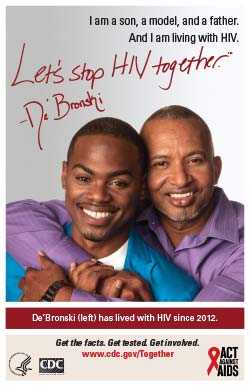National Black HIV/AIDS Awareness Day
 February 7 is National Black HIV/AIDS Awareness Day (NBHAAD). This year’s theme, I Am My Brother’s and Sister’s Keeper, emphasizes our responsibility to stand united with our family and friends in the fight against HIV and AIDS.
February 7 is National Black HIV/AIDS Awareness Day (NBHAAD). This year’s theme, I Am My Brother’s and Sister’s Keeper, emphasizes our responsibility to stand united with our family and friends in the fight against HIV and AIDS.
Blacks/African Americans* continue to experience higher rates of HIV compared to other races and ethnicities. In 2015, African Americans made up about 12% of the US population, but accounted for 45% of new HIV diagnoses. Among all African Americans, African American gay and bisexual men account for the majority (58% ) of new diagnoses.
We are seeing encouraging signs of progress. From 2010 to 2014, HIV diagnoses among African American women fell by nearly 25%. According to a recent Vital Signs report, HIV diagnoses have also fallen sharply among African Americans who inject drugs. After years of increases, HIV diagnoses have stabilized among African American gay and bisexual men. This progress suggests that focused HIV prevention efforts are having an effect and need to continue.

Doing It delivers the message that HIV testing should be a part of everyone’s regular health routine to keep ourselves and our community healthy. Visit Act Against AIDS for campaign resources.

Let’s Stop HIV Together fights stigma and seeks to ensure that all Americans know the facts about HIV. Visit Act Against AIDS for campaign resources.
What Can You Do?
Get educated and get involved. Learn the basics about HIV and its impact on African Americans, and share this lifesaving information with others. Through its Act Against AIDS campaigns and partnerships, CDC provides African Americans with effective and culturally appropriate messages about HIV prevention, testing, and treatment.
Get tested. Knowing your HIV status gives you important information to help keep you and your partner healthy.
To find a testing site near you, visit Get Tested, text your ZIP code to KNOWIT (566948), or call 1-800-CDC-INFO. Many testing locations are free and confidential. You can also use a home testing kit, available in drugstores or online.
Find more information about HIV testing on CDC’s HIV Testing Basics page.
Protect yourself and your partner. Today, if you are sexually active, more tools than ever are available to prevent HIV.
- Use condoms the right way every time you have sex. Learn the right way to use a male condom or a female condom.
- Choose less risky sexual behaviors.
- Limit your number of sexual partners.
- Get tested and treated for other sexually transmitted diseases (STDs).
- Never share needles or works.
- If you are at high risk for HIV, take daily medicine to prevent HIV, called pre-exposure prophylaxis (PrEP).
- Take antiretroviral medicine, called post-exposure prophylaxis (PEP), if you think you have been exposed to HIV in the last 72 hours and are not on PrEP.
- Remember, abstinence is the only 100% effective way to prevent HIV.
Get treated. If you are living with HIV, start medical care and begin taking medicine to treat HIV, called antiretroviral therapy (ART), as soon as possible. If taken the right way every day, ART can reduce the amount of HIV in your body. Having a low amount of HIV (viral load) is good for your overall health and can greatly reduce the chance of transmitting HIV to your partner. Learn more about how you can live well with HIV.
Learn more about how to protect yourself and your partners and get information tailored to meet your needs from CDC’s HIV Risk Reduction Tool (BETA).
* Referred to as African Americans in this feature.
More Information
- Page last reviewed: February 3, 2017
- Page last updated: February 3, 2017
- Content source:
- National Center for HIV/AIDS, Viral Hepatitis, STD, and TB Prevention
- Page maintained by: Office of the Associate Director for Communication, Digital Media Branch, Division of Public Affairs




 ShareCompartir
ShareCompartir